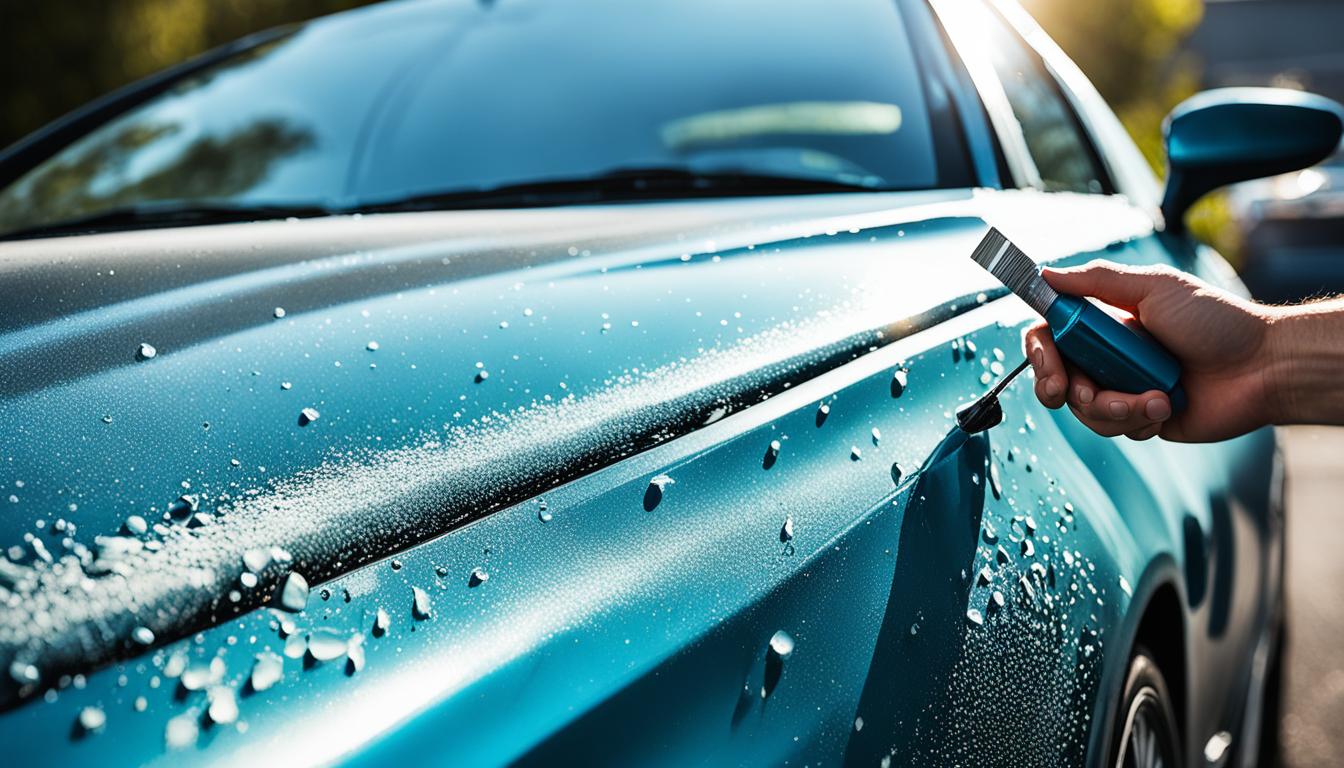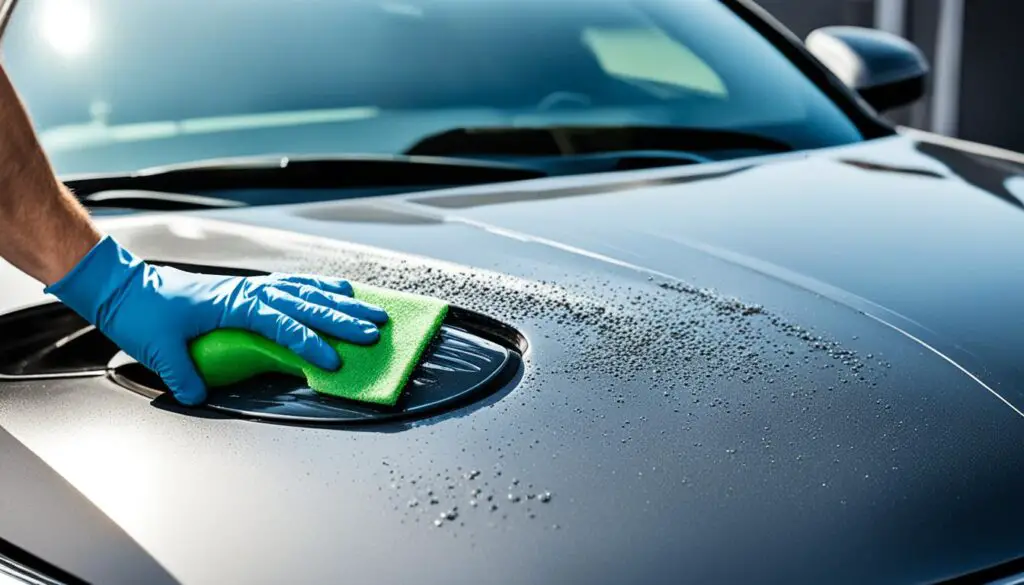
Transform Your Vehicle: Secrets of Car Paint Restoration
Improving your car’s paint can drastically make it look better and worth more. This is true whether you own a vintage car with its first paint or a new one with chipped paint. In this article, I’ll offer tips and methods for getting your car’s paint back to new.
These insights come from experts and cover the whole paint restoration process.
Key Takeaways:
- Car paint restoration can greatly enhance the appearance and value of your vehicle.
- Thorough surface preparation is essential before starting the restoration process.
- Paint correction techniques like polishing and compounding can remove imperfections and restore glossiness.
- Protecting the restored paint with ceramic coatings or paint protection film is crucial for long-lasting results.
- Car paint restoration is a rewarding DIY project that can transform your vehicle’s aesthetic.
The Importance of Surface Preparation
Before you start restoring your car’s paint, you need to clean it well. This step is critical for a successful paint correction. A clean surface ensures the correction process gives your car a perfect finish.
Cleaning Car Paint
Wash your car with a top-quality soap made for cars. This gets rid of dirt and other impurities. Always use a soft, microfiber wash mitt to protect the paint from scratches. Clean the car a section at a time and rinse the mitt often to avoid spreading dirt.
Removing Contaminants from Car Paint
Sometimes, regular washing isn’t enough to get rid of all dirt. For tough dirt and spots, a clay bar is a great solution. It gently pulls out the dirt without harming the paint. Applying a clay lubricant, move the clay bar back and forth. This removes deep contaminants like sap and tar.
Tip: Before using a clay bar, be sure to wash your vehicle well. This step takes out most of the dirt, preventing the clay bar from scratching your car.
After this cleaning process, your car’s surface will be smooth and ready for the next step. You’ll now be able to correct any paint issues effectively. This leads to a perfect, professional finish.

Understanding Paint Correction Techniques
Paint correction is key for restoring a car’s paint. It gets rid of flaws and brings back the shiny paint look. By using certain polishing methods, such as with dual-action polishers and special compounds, you can make your car’s paint look brand new.

Polishing gets rid of swirl marks and light scratches. It also makes the paint surface shiny again. This process uses a dual-action polisher with a soft pad and a polish compound. The polisher makes sure the process is smooth, and the compound has tiny particles that take out the flaws.
“Polishing your car’s paint is like giving it a revitalizing spa treatment. It smooths out the surface, enhances its shine, and restores that showroom finish.”
If the car’s paint has very deep scratches or lots of oxidation, compounding might be needed. Compounding is a stronger method that involves using compounds. These compounds have abrasives that can remove bigger scratches and oxidation. But, it is essential to be careful because too much force can harm the paint. Always work slowly and with care to get the best results without damaging the paint.
Paint correction needs patience, carefulness, and a good eye for detail. Take it slow, work bit by bit, and always check your work. Even though it takes practice to master, the outcome is always impressive.
Protecting and Maintaining the Restored Paint
After fixing your car’s paint, the work isn’t over. Now, protect your work with a ceramic coating or a paint protection film. These keep your paint looking great for years.
A ceramic coating guards against the sun, acid rain, and contaminants. It creates a strong layer over your paint, protecting it. This layer keeps your car looking like new.
On the other hand, a paint protection film (PPF) stops scratches and rock chips. Applied to your car’s most at-risk areas, it takes the hit first. This keeps your paint safe from damage.
Both coatings and films help your paint last longer. They also make keeping your car clean easy. Their smooth surfaces push off dirt and water.
Don’t forget to do regular upkeep. This keeps your paint shiny. Here are tips to care for your restored paint:
- Wash with a gentle formula to clean, not harm, the coating.
- Dry completely to avoid ugly water spots.
- Avoid rough cleaning materials that might scratch the paint.
- Use a special spray to maintain the coating’s protection and gloss.
By sticking to these care steps and using coatings or films, your paint will stay stunning. Your hard work will pay off for a long time.
Benefits of Ceramic Coating and Paint Protection Film
Getting a ceramic coating or a paint protection film comes with many pluses:
- Long-lasting protection: They guard against scratches, swirls, and fading for years.
- UV shield: These formulas fight off UV rays, stopping paint damage.
- Easy to clean: They make the car easy to wash and keep glossy.
- Value saver: They protect your car’s look, helping it keep its value.
| Ceramic Coating | Paint Protection Film |
|---|---|
| Defends against UV rays and dirt for a long time. | Blocks scratches and rock dings. |
| Repels grime and water to keep the car clean. | Keeps the original paint untouched for future touch-ups. |
| Makes your paint shine like new from the showroom. | It’s nearly invisible, guarding without you seeing it. |
Use the right care and protection to keep your car’s paint looking new. Enjoy the advantages of paint protection. It will keep your car shining wherever you go.
Conclusion
Car paint restoration is a rewarding DIY project. It changes how your vehicle looks. By using the correct techniques and tools, you can make your car look brand new.
Restoring paint that’s faded or damaged makes your car more valuable. It also keeps the car looking good.
Starting a car paint restoration project opens up new chances. You get to refresh your car’s color and make it beautiful again. Your car will not only look great but also grab people’s attention on the road.
Putting in time to restore your car’s paint is smart. It makes your vehicle look better and protects it. This choice improves your car’s value and keeps it looking good for longer.
Get ready to dive into the world of car paint restoration. With your interest in making cars beautiful, your car will look amazing again.
FAQ
Why is car paint restoration important?
Restoring your car’s paint can make it look better and worth more. Whether it’s an old car with its original paint or a newer one with faded colors, fixing the paint is a good move.
What is the first step in car paint restoration?
Cleaning the car is the first step. You should use special soap meant for cars and soft wash mitts. This step gets rid of dirt and grime. A clay bar can help remove any tough spots on the paint.
What is paint correction?
Paint correction brings the shine back to your car. It involves polishing the paint. A dual-action polisher and polishing compound can get rid of swirling marks and light scratches. For deeper scratches and really worn paint, you might need to compound the paint.
How can I protect the newly restored paint?
You can protect your car’s paint by adding a ceramic coating or a protective film. These coatings keep the paint safe from the sun, pollution, and more. They help the paint stay looking new. Regularly caring for the paint is also very important.
Why should I consider car paint restoration?
Repairing your car’s paint is a fun DIY project that can really make your car stand out. If you do it right, your car could look like it just came from a professional shop. Also, a well-maintained paint job can boost your car’s value and charm.
Source Links
- https://www.apruniversity.com/blog/achieving-a-professional-finish-unveiling-the-secrets-of-car-paint-restoration
- https://www.autogeekonline.net/forum/how-to-articles/25304-secret-removing-oxidation-restoring-show-car-finish-antique-single-stage-paints.html
- https://www.bluestarbrothers.com/revive-your-ride-car-paint-restoration-tips-for-faded-glory
